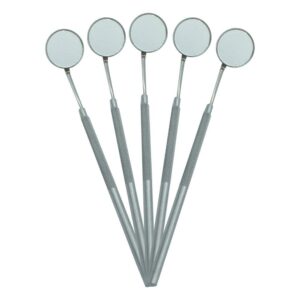The Future of Dental Materials: Innovations and Advancements
The Future of Dental Materials: Innovations and Advancements
The field of dentistry is constantly evolving, and one of the most exciting areas of innovation is in dental materials. From new materials that are stronger and more durable to those that promote better patient outcomes, the future of dental materials is bright. In this blog post, we’ll explore some of the latest innovations and advancements in dental materials that will shape the future of dentistry.
Composite Materials
Composite materials have been used in dentistry for many years, but recent advancements have made them even more versatile and effective. One of the biggest advantages of composite materials is that they can be matched to the natural color of the patient’s teeth, making them an excellent choice for cosmetic procedures. In addition, they are now stronger and more durable than ever before, making them an ideal choice for fillings, crowns, and other restorative procedures.
Nanotechnology
Nanotechnology is a relatively new field, but it has already made a significant impact in dentistry. Nanoparticles can be used in dental materials to improve their mechanical properties, increase their strength, and make them more resistant to wear and tear. In addition, nanoparticles can be used to deliver medication directly to the affected area, which can help to improve patient outcomes and reduce the need for invasive procedures.
3D Printing
3D printing is revolutionizing many industries, and dentistry is no exception. With 3D printing, dentists can create custom dental implants, crowns, and other restorative devices that are perfectly tailored to the patient’s needs. This not only improves patient outcomes but also reduces the time and cost associated with traditional manufacturing methods.
Regenerative Materials
Regenerative materials are a new class of dental materials that can actually promote the growth of new tissue in the mouth. These materials can be used to repair damaged teeth, bones, and other structures, and they have the potential to completely change the way that dentists approach restorative procedures. By promoting the growth of new tissue, regenerative materials can help to restore the natural function and appearance of the mouth.
Conclusion
The future of dental materials is bright, and these innovations and advancements are just the beginning. From composite materials that match the natural color of the teeth to regenerative materials that promote the growth of new tissue, these new materials are improving dental procedures and patient outcomes. As these technologies continue to evolve, we can expect to see even more exciting developments in the field of dentistry.
Advancements in Dental Materials Testing
In addition to the innovations in dental materials themselves, there have also been advancements in the testing methods used to evaluate them. Traditional testing methods have relied on laboratory studies and animal models, but new technologies are now allowing researchers to simulate real-world conditions more accurately.
For example, researchers can now use digital simulations to test how dental materials will perform in the mouth. These simulations can take into account factors like temperature, pressure, and the presence of bacteria and other substances that are normally found in the mouth. By using these advanced testing methods, researchers can better evaluate the safety and efficacy of new dental materials before they are used in clinical settings.
The Role of Artificial Intelligence in Dental Materials
Artificial intelligence (AI) is also starting to play a role in the development and testing of new dental materials. AI algorithms can analyze large amounts of data to identify patterns and trends that might not be apparent to human researchers. This can help to speed up the development process and make it more efficient.
For example, AI can be used to analyze the structure of new materials and predict how they will perform under different conditions. This can help researchers to identify promising new materials more quickly and reduce the need for expensive and time-consuming laboratory tests.
The Impact of Dental Materials on Sustainability
As sustainability becomes an increasingly important concern in all industries, it is also starting to impact the development of dental materials. Traditional materials like metals and plastics are not always environmentally friendly, and researchers are now looking for more sustainable alternatives.
One area of focus is on biodegradable materials that can break down naturally in the environment. These materials can be used for temporary restorations and other applications where the material will only be in the mouth for a short period of time. In addition, researchers are also exploring the use of materials that are derived from renewable sources, such as plant-based plastics.
Conclusion
In conclusion, the future of dental materials is exciting and full of possibilities. With the continued advancements in composite materials, nanotechnology, 3D printing, regenerative materials, testing methods, and artificial intelligence, dentists will be able to offer patients safer, more effective, and more personalized treatments. As sustainability becomes a greater concern, the development of new dental materials will also focus on environmentally-friendly alternatives. These innovations in dental materials will improve patient outcomes and contribute to the overall advancement of the field of dentistry.
The Importance of Collaboration in the Development of Dental Materials
Another key aspect of the future of dental materials is the importance of collaboration between different disciplines. Dental materials development involves a range of fields, including materials science, chemistry, engineering, and dentistry. Collaboration between experts in these different areas can lead to new insights and breakthroughs that might not have been possible otherwise.
In addition, collaboration between dental professionals and patients is also important. Patient feedback can provide valuable insights into how new materials are performing and how they can be improved. By involving patients in the development process, dental professionals can create materials that are better suited to their needs and preferences.
Challenges Facing the Future of Dental Materials
While the future of dental materials is full of possibilities, there are also some challenges that need to be addressed. One of the biggest challenges is the need for long-term studies to evaluate the safety and efficacy of new materials. While laboratory studies and short-term clinical trials can provide valuable information, long-term studies are needed to assess the durability and performance of materials over time.
Another challenge is the need for better regulation and standardization of dental materials. There are currently no universally accepted standards for the testing and evaluation of dental materials, which can make it difficult to compare different materials and evaluate their performance. Improved regulation and standardization would help to ensure that patients receive the highest quality dental materials and that dental professionals can make informed decisions about which materials to use.
Conclusion
The future of dental materials is bright, with innovations and advancements that are improving patient outcomes and changing the way that dentistry is practiced. From composite materials to regenerative materials, nanotechnology to 3D printing, and the use of artificial intelligence, the field of dental materials is advancing rapidly. Collaboration between different disciplines and between dental professionals and patients will be key to the continued development of new materials that are safer, more effective, and more sustainable.
Future Trends in Dental Materials
Looking ahead, there are several trends that are likely to shape the development of dental materials in the coming years. One trend is the increasing use of 3D printing technology in the production of dental restorations. 3D printing allows for the creation of highly personalized and precise restorations, which can improve patient outcomes and reduce the need for multiple appointments.
Another trend is the development of smart materials that can respond to changes in the environment or in the body. For example, researchers are exploring the use of materials that can release drugs or other therapeutic agents in response to certain stimuli, such as temperature or pH changes.
Additionally, the use of regenerative materials is expected to become more widespread in the coming years. Regenerative materials can stimulate the growth of new tissue and help to restore damaged or missing teeth. These materials have the potential to revolutionize the field of restorative dentistry and provide patients with more natural-looking and long-lasting restorations.
The Importance of Continuing Education in Dental Materials
As the field of dental materials continues to evolve, it is important for dental professionals to stay up-to-date with the latest advancements and trends. Continuing education courses and seminars can provide valuable information on new materials and techniques, and help dental professionals to improve patient outcomes and stay ahead of the curve.
In addition, dental professionals should be actively involved in the development and evaluation of new materials. By participating in research studies and clinical trials, dental professionals can help to ensure that new materials are safe, effective, and meet the needs of patients.
Conclusion
In conclusion, the future of dental materials is bright, with new innovations and advancements that are improving patient outcomes and changing the way that dentistry is practiced. From 3D printing to smart materials and regenerative materials, the field of dental materials is rapidly advancing. By staying up-to-date with the latest developments and actively participating in the development and evaluation of new materials, dental professionals can provide their patients with the highest quality care and the most advanced treatments available.
FAQ
Q: What are dental materials?
A: Dental materials are materials used to restore and repair teeth and other structures in the oral cavity. Examples include composite resins, ceramics, metals, and cements.
Q: What is the future of dental materials?
A: The future of dental materials is bright, with new innovations and advancements that are improving patient outcomes and changing the way that dentistry is practiced. This includes the use of 3D printing, smart materials, and regenerative materials.
Q: What are smart materials?
A: Smart materials are materials that can respond to changes in the environment or in the body. In dentistry, smart materials might be used to release drugs or other therapeutic agents in response to certain stimuli, such as temperature or pH changes.
Q: What are regenerative materials?
A: Regenerative materials are materials that can stimulate the growth of new tissue and help to restore damaged or missing teeth. These materials have the potential to revolutionize the field of restorative dentistry and provide patients with more natural-looking and long-lasting restorations.
Q: How can dental professionals stay up-to-date with the latest developments in dental materials?
A: Dental professionals can stay up-to-date with the latest developments in dental materials by attending continuing education courses and seminars, participating in research studies and clinical trials, and networking with other dental professionals and researchers in the field.
Q: What are some of the challenges facing the future of dental materials?
A: Some of the challenges facing the future of dental materials include the need for long-term studies to evaluate the safety and efficacy of new materials, and the need for better regulation and standardization of dental materials. Improved regulation and standardization would help to ensure that patients receive the highest quality dental materials and that dental professionals can make informed decisions about which materials to use.





